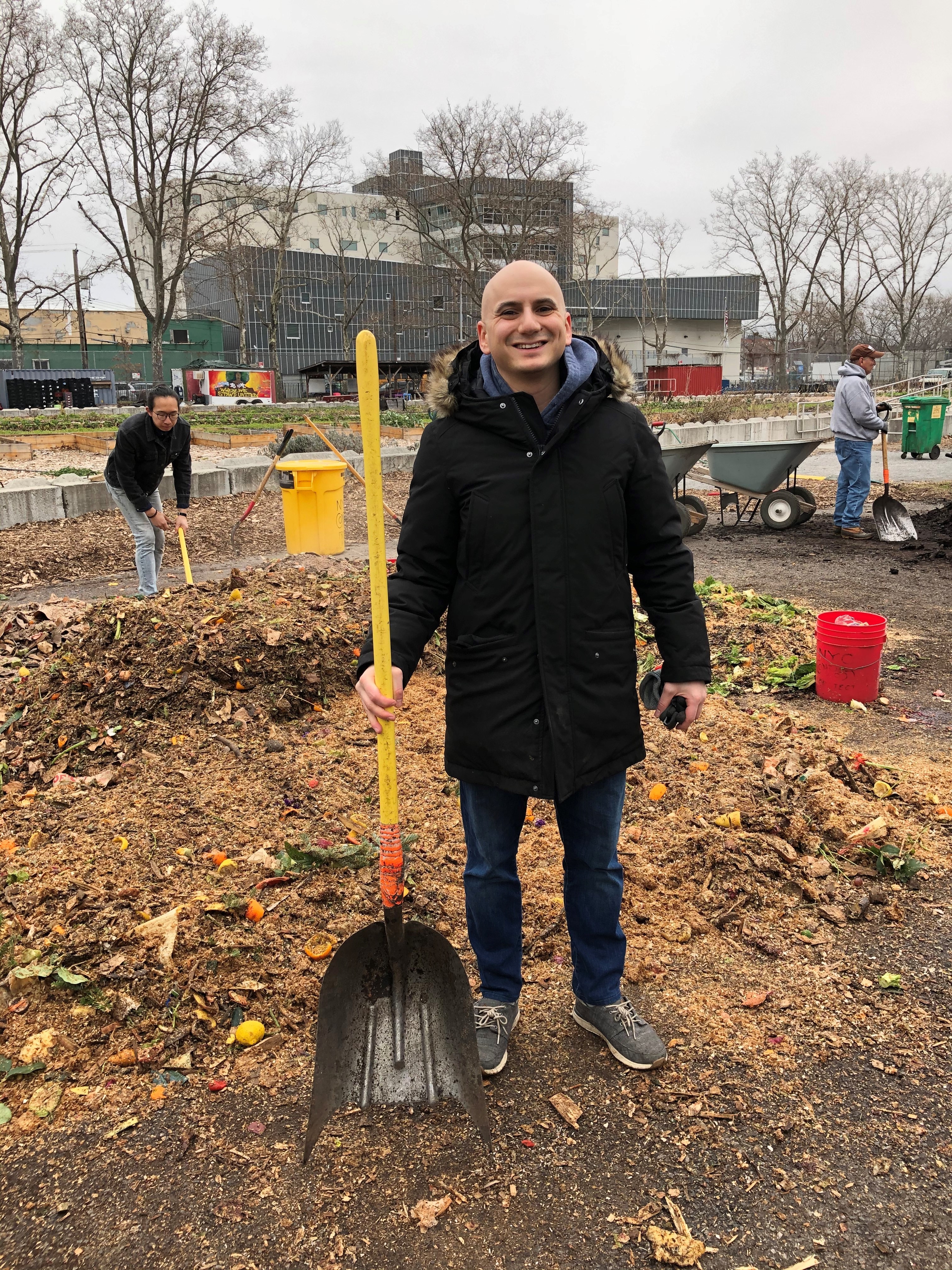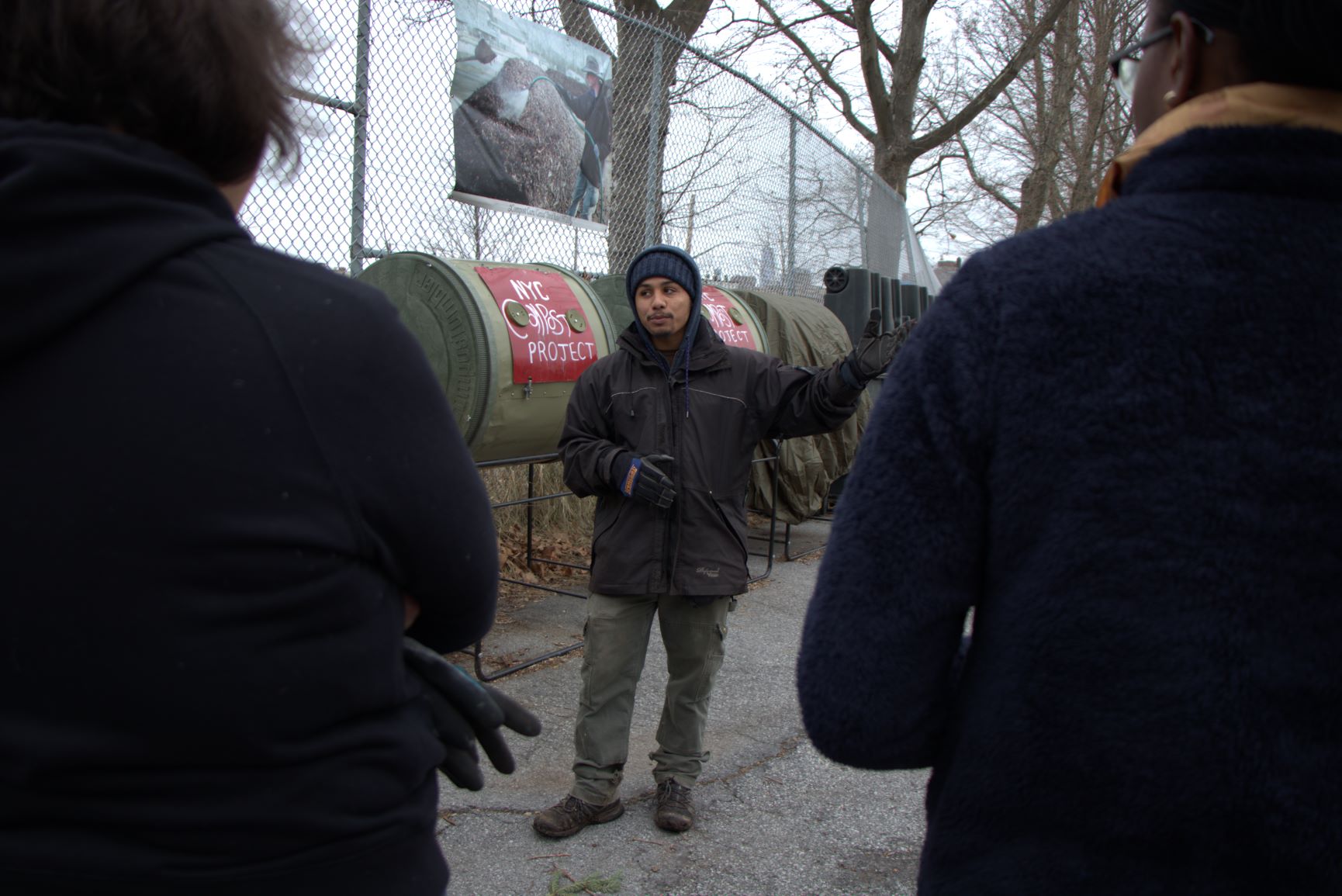Beyond the Bottom Line: No Grief in the Compost Heap
I went to this NFF volunteer day to do my part for the environment, but also to see if one person in particular could give me hope.
What we did
At the end of a three-hour volunteer shift at Red Hook Community Farm, I stood in front of a compost pyramid taller than me with a smile on my face. My colleagues and I had contributed to the largest compost site in the country that uses no fossil fuels, instead utilizing, solar and wind, and humans over trucks and machines. I knew our work was important here. With only two employees, down from three last year due to budget cuts, the site is processing about 50 percent the space could handle if it had four employees. Volunteers are essential.

"NYC sends about 1.2 million tons of food waste to landfill every year. Was this little bit of compost even worth it?"
I didn’t know what to expect when I got there, but they put me to work right away. Picture me holding a long stick with a flat, sharp edge and hacking away at a whole butternut squash. “This makes it break down faster, plus it's great way to get out some aggression,” joked Domingo Morales, who runs the site. When I had a hard time pinning down small lemons and apples, he told me to just step on them with my heel, and yell, “squirt alert!” I understood why when I pounced on the lemon and its juice sprayed out far and wide.
Once we had a nice pile of food scraps, the next step was to mix it with brown, carbon-based materials, such as wood chips and shavings and coffee chaff (the dried husk of the bean). Mixing these with the food created the aerobic process that breaks down the nitrogen-based food items. This prevents the food from emitting methane, a powerful greenhouse gas, as it would in a landfill.

We then poured buckets of brown materials over the food, scraped our shovels on the floor to dig up big scoops, flipped them over and dragged them around to mix the materials around. We formed the mixed material into a pyramid shape by shoveling and flinging it higher and higher.
It was all quite a workout-- but that was only phase one.
One of the ways the site keeps pests such as rats and possums out is covering the nascent compost with matured compost that has already broken down. So, we took barrels of aged compost and shoveled again, this time over the mound, creating a compost cover about a foot deep. Domingo explained that inside this cover, the new compost will break down naturally, reaching a temperature of about 150 Fahrenheit (measured with a giant thermometer). The covered compost prevents foul odor, which is pleasant but also keeps pests from scavenging for food. Domingo said that before they implemented this method, it wasn’t uncommon to catch a rat in your shovel and watch it squeal as it got flung in the air.
The mounds sit for a few weeks and get turned and aerated every 7-10 days. Then, about a quarter of the mounds are sifted to remove large wood chips and any inorganic materials and sent to local farms and gardens to be used as soil. The rest are used as cover for new compost heaps.
What it all meant
When we were done, I felt satisfied from the physical workout and contributing to reducing emissions. But it was also a humbling experience. The work happening there is so important but totally undervalued and under resourced. NYC sends about 1.2 million tons of food waste to landfill every year. The carbon footprint of such waste is sobering. Was this little bit of compost even worth it?
Domingo was trained to do this work by David Buckel, a former gay rights lawyer turned environmentalist and composter who used to run Red Hook site. In April 2018, Buckel died by suicide when he set himself on fire in Prospect Park as a protest of fossil fuels. In his suicide note, Buckel said, “Pollution ravages our planet, oozing inhabitability via air, soil, water and weather... my early death by fossil fuel reflects what we are doing to ourselves."
I remember when this happened because it was when I was researching climate grief—the feeling of mourning over what the future is projected to look like because of climate change. I wound up writing my capstone at grad school on this topic, and my research found that many people have this existential dread, even if they don’t talk about it. It can cripple their motivation to take action. I admit I’ve felt this way before.

At Buckel’s memorial, Domingo said this:
“It is too easy to live the way we have been living. The majority of us are accustomed to a convenient lifestyle… we have made unsustainable practices the foundation for our civilization. David had a point. It will be hard for us to fix the problems that we face. But we will not give up... We will fight for a better future together. In honor of the late David Stroh Buckel.”
Part of the reason I wanted to visit the farm was to see how Domingo was doing. Has he kept going? What I saw was a person who was remarkably upbeat. He joked with us about how it helps to flick a leg up behind you in the air when shoveling, not just for functionality but because it’s like a Disney princess “kiss” moment. He demonstrated with a big, cheeky smile on his face. He told us how he's learning Japanese because his girlfriend is from Japan and how he teaches biology classes to youth from Crown Heights and Bed-Stuy at Brooklyn Botanical Garden. He was full of life.
Yet he seemed to fully understand how small a contribution the farm is to the larger-than-life problem of climate change, detailing many ways the city falls short on composting, let alone other environmental challenges. But he didn’t seem phased by it. He’s out there every day, shoveling for hours while smiling like a Disney princess. If he can do that, surely I can do more, and with a smile on my face.
